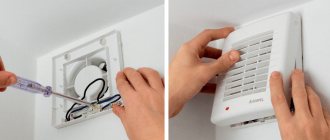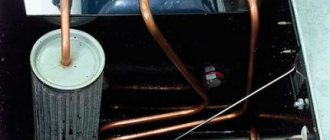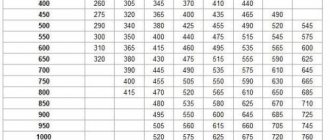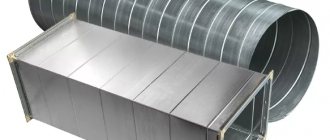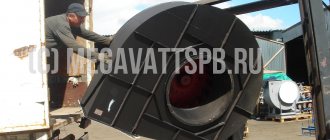PHYSICAL COMPONENTS OF CALCULATIONS
According to the method of operation, ventilation circuits are currently divided into:
- Exhaust. To remove used air.
- Inlet. To let in clean air.
- Recuperative. Supply and exhaust. Remove the used one and bring in a clean one.
In the modern world, ventilation schemes include various additional equipment:
- Devices for heating or cooling supplied air.
- Filters for purifying odors and impurities.
- Devices for humidification and air distribution throughout rooms.
When calculating ventilation, the following values are taken into account:
- Air consumption in cubic meters/hour.
- Pressure in air channels in atmospheres.
- Heater power in kW.
- Cross-sectional area of air channels in sq. cm.
How to find out the fan performance
Modern fan
When purchasing a ventilation device, everyone wants to know and check its performance. The productivity of the described device is the volume of air pumped over a certain unit of time. That's why everyone wants to buy a device with more performance! It is measured in “CFM”, which means cubic feet per minute or m³ (cubic meters) per hour.
An equally important characteristic of this device is its power, which is measured in “kW” and “kW”. In this case, the variable value is the rotation speed, measured in the number of revolutions produced per minute.
Calculation of the fan, or rather its performance, also involves:
- blade diameter;
- noise level;
- full pressure.
The fan performance is indicated on the packaging of the device or stated in the instructions supplied with it. Normally, such a device refreshes the air in the room every 4 minutes. An important indicator is the volume of available space. The larger it is, the greater the load on the described device. By the way, you can calculate the volume of a room where you need to “renew the air” using a simple school formula: multiplying the height by the width and length!
The required shift rate recommended by SNiP is the range from 10 to 12 times per hour. By multiplying the available volume of the room by any value from this range, you can obtain the required performance in a separate room. By summing the resulting value with calculations of the area for all rooms of the house, you can find out the required productivity for the entire living area.
In practice, the standards required by calculations are rarely implemented, so in real conditions everything is somewhat different, which concerns good air flow. So, for the minimum established rate of air exchange in a room, it is enough to open a window or rely on the draft created in the ventilation duct.
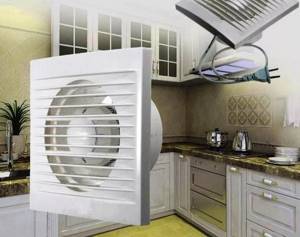
Kitchen exhaust fan
Bathrooms and kitchens require fans with higher performance or they must run longer here than in other rooms, since taking a shower and cooking leads to a change in the composition of the air, saturating it with water vapor and carbon monoxide. For such rooms, the operation of the device in a “reinforced hood” is suitable, which must be installed on the device.
An important role is played by the installation of an axial fan, which is a bladed blower that transmits mechanical energy from the rotation of the blades located on the impeller in the form of kinetic and potential energy. Calculation of the air exchange of axial fans is carried out taking into account the efficiency (efficiency factor), aerodynamic characteristics of the device and unit performance. This value may also be indicated in the instructions supplied with the device.
Calculation of exhaust ventilation example
Before starting the calculation of exhaust ventilation, it is necessary to study the SN and P (System of Norms and Rules) design of ventilation systems. According to SN and P, the amount of air required for one person depends on his activity.
Low activity – 20 cubic meters/hour. Average – 40 kb.m./hour. High – 60 kb.m./h. Next, we take into account the number of people and the volume of the room.
In addition, you need to know the frequency - a complete exchange of air within an hour. For a bedroom it is equal to one, for living rooms - 2, for kitchens, bathrooms and utility rooms - 3.
For example, calculate the exhaust ventilation of a room of 20 sq.m.
Let's say two people live in a house, then:
V (volume) of the room is equal to: SxH, where H is the height of the room (standard 2.5 meters).
V = S x H = 20 x 2.5 = 50 cubic meters.
Next V x 2 (multiplicity) = 100 kb.m./h. Otherwise – 40 kb.m./h. (average activity) x 2 (persons) = 80 cubic meters/hour. Choose a higher value – 100 kb.m./h.
In the same order, we calculate the exhaust ventilation performance of the entire house.
How to increase fan performance
The presence of fresh air in the premises is the key to good work and excellent well-being of all household members. This can be organized by installing fan equipment in the room that can evenly cool the room. At the same time, its quiet operation, which does not create discomfort for others, is important.
It is desirable to create an unimpeded flow of air from the ceiling to the floor, which could be freely distributed around the entire perimeter of the room. Thanks to this, the device will heat up less and its performance will increase.
From a school physics course we know that cold air occupies the bottom of the room, and hot air occupies the top. Therefore, it is recommended to install an air outflow at the bottom of the room. The presence of active air outflow and inflow requires the installation of exhaust/injection fans of equal performance.
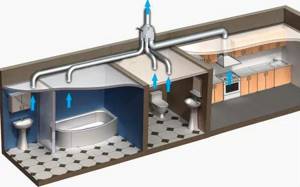
Ventilation system
You can increase the performance of the fan by switching it to efficient operation mode. In this case, the operation of the device should be minimal when household members are not at home. In other situations, it is recommended to increase the air supply in the room where people are. If there is an active cooking process in the kitchen and the shower is running for a long time, it is recommended to increase the local air supply in these rooms to the maximum. Such “smart” ventilation can quickly and efficiently exchange air in any room.
For the described ventilation system, a special control unit is equipped, which is connected to the processor. Sensors that can detect:
- degree of movement;
- amount of carbon dioxide;
- relative air humidity.
Responsible for the selected operating mode is the “control unit”, which sets the operating mode for the exhaust pumps. These devices can serve one or several rooms. The number of such devices depends on the area of the room. The hood from the kitchen is also connected here.

Kitchen hood
The advantage of using the described “smart” ventilation system is the correct regulation of the performance of exhaust fans, allowing you to reduce the amount of air pumped over 24 hours by almost half. It also consumes less electricity, which is a big plus for family budgets.
Calculation of exhaust ventilation for industrial premises
When calculating the exhaust ventilation of a production room, the multiplicity is 3.
Example: garage 6 x 4 x 2.5 = 60 cubic meters. 2 people work.
High activity – 60 cubic meters/hour x 2 = 120 cubic meters/hour.
V – 60 cubic meters x 3 (multiplicity) = 180 kb.m./h.
We choose a larger one - 180 cubic meters / hour.
As a rule, unified ventilation systems are divided into:
- 100 – 500 cubic meters/hour. - apartments.
- 1000 – 2000 cubic meters/hour. – for houses and estates.
- 1000 – 10000 cubic meters/hour. – for factory and industrial facilities.
Calculation of supply and exhaust ventilation
AIR HEATER
In the middle climate, the air entering the room must be heated. To do this, supply ventilation is installed with heating of the incoming air.
Heating of the coolant is carried out in various ways - with an electric heater, the intake of air masses near radiator or stove heating. According to SN and P, the temperature of the incoming air must be at least 18 degrees. Celsius.
Accordingly, the power of the air heater is calculated depending on the lowest (in a given region) street temperature. Formula for calculating the maximum heating temperature of a room with an air heater:
N/V x 2.98 where 2.98 is a constant.
Example: air flow – 180 cubic meters/hour. (garage). N = 2 kW.
Further 2000 W / 180 kb.m./h. x 2.98 = 33 deg.c.
Thus, the garage can be heated to 18 degrees. At outside temperature minus 15 degrees.
How to choose the right fan for forced ventilation of the bathroom and other rooms
Forced ventilation using fans is necessary where there is no good natural draft. The selected fan model must correspond in power to the volume of the room and its purpose. Most often, fans are installed in blind rooms without windows: toilets and bathrooms.
Why do you need an exhaust fan?
Exhaust fans are very neat and easy to use
In most apartment buildings, for various reasons, natural ventilation does not work.
The most affected areas are those with high humidity or the release of heat and odors: kitchens and bathrooms.
Here, condensation settles on the glass and tiles, mold appears in the corners, and unpleasant odors spread into the living rooms.
A fan for apartment ventilation will save the situation. It will draw out moist exhaust air and create the necessary air exchange.
In order for the appearance of a fan in the ventilation system to be truly useful, the device is selected for a specific room according to certain parameters.
Too powerful, it will cause drafts that are completely unacceptable for the bathroom. And a weak fan will not cope with its function, wasting the owner’s kilowatts in vain.
Types of fans
bathroom fans with built-in lamp
There are several types of fans on the market for ventilation of domestic premises for various purposes.
Structurally, they are all divided into three types:
- Axial;
- Centrifugal;
- Duct.
Axial fans are exactly the type that are installed in apartments. Axial fans for exhaust ventilation work very efficiently, are easy to install, and are therefore suitable for premises of any purpose.
Centrifugal fans are commonly used in large industrial systems and for tunnel ventilation. Centrifugal fans are called “snails” because the body resembles a gastropod shell.
They are quite bulky, so installing them in an apartment is difficult. But some manufacturers create compact household models for bathrooms.
This type of equipment is 2.5 - 3 times more expensive than the previous one, but the performance of the ventilation fan is several times higher with the same power.
The intensity of fan operation in a ventilation system depends on the size and shape of the blades. Centrifugal fans create high pressure, reducing losses when air moves along winding networks and even during climbs.
Duct fans for forced ventilation are installed directly into the air duct. There are models for round and rectangular sections. In addition to the main function, duct fans are equipped with humidity and shutdown sensors.
Such devices start when a given level of humidity in the room is reached and stop automatically. Duct exhaust fans are often hidden in a moisture-proof casing.
Therefore, they can be installed in saunas, indoor swimming pools, winter gardens and other damp places.
Silent duct fan
Depending on the location of installation, household fans are divided into:
- for the bathroom;
- kitchen;
- for bathrooms;
- window;
- ceiling;
- high temperature.
Household fans with a check valve are designed specifically for ventilation of kitchens and bathrooms of apartment buildings. The valve prevents exhaust air from returning from the exhaust duct to the apartment.
Irresponsible residents of houses independently insert fans for ventilation of the bathroom or kitchen into the central exhaust duct, causing it to depressurize. Exhaust air from the kitchen or toilet spreads to neighboring apartments.
Therefore, it is advisable to install a fan with a check valve in the kitchen and bathroom.
Household fans with ventilation grilles have a power of no more than 3 thousand cubic meters of air per hour and are built into ducts no more than 400 mm in diameter.
In residential buildings, wall fans are usually used, since the outlets from the ventilation ducts are located in the walls.
Silent fans cannot be called a separate category, but it is precisely by this indicator that home appliances are often selected.
A silent fan for ventilation of rooms is ideal for small apartments. Quiet operation is ensured by the special shape of the blades and their slower movement.
Most often, silent axial fans are purchased for domestic exhaust ventilation.
High-temperature fans are installed in saunas, steam rooms, and fireplace rooms to eliminate steam and smoke from the room. Equipment of this class can withstand temperatures of 70 – 180 degrees Celsius. When purchasing a fan for forced ventilation of a sauna, it is advisable to select a model with additional protection against moisture getting on electrical parts (IP class protection).
In addition to those listed above, there are also corrosion-resistant, spark-proof, smoke removal, dust and jet fans for tunnel ventilation. These are powerful and large devices used in industrial systems. We dwell in detail only on household models.
Criteria for selecting a fan for forced ventilation
Performance is the main indicator that people pay attention to when choosing a fan for ventilation of an apartment. Fan performance is calculated using the following formula:
P = Kv * O,
where Kv is the exchange rate for a given room, O is the volume of the room.
The air exchange rate depends on the purpose of the room; this is a constant indicator indicated in SNiP.
Another 10–15% error is added to the resulting figure.
fan - the main element of exhaust ventilation
The noise level is very important when selecting a fan for ventilation of a small apartment. During operation, any type of fan produces two types of noise: aerodynamic and mechanical.
Mechanical noise occurs when the body vibrates, blades rub, or loose parts rattle. Aerodynamic noise occurs when air moves through air ducts and between fan blades.
The noise level of a fan operating in a residential area should not exceed 25 decibels. For the kitchen, they purchase appliances that produce up to 35 decibels.
Fans for ventilation of the bathroom and toilet may be a little louder, because they turn on for a short period of time. Noise characteristics are indicated in the documentation for the device.
To reduce noise, an insulating box and a silencer are installed. But this option is used in industrial fan systems for ventilation of tunnels.
The degree of moisture protection is an important point when choosing a fan for a bathroom, sauna and ventilation of other rooms with difficult climatic conditions.
Any fan is powered by electric traction, so it is necessary to protect the contacts from the penetration of moisture and steam. Otherwise, there is a risk of electrical short circuit and even fire.
Fans running on 24 V are less dangerous.
heat resistant sauna fan
The degree of heat resistance is taken into account when purchasing a fan for ventilation of rooms with fireplaces, steam rooms and baths. The fan housing must withstand high temperatures, so it is made of metal.
Ease of use is not the last parameter when choosing a fan with a ventilation grille.
You can purchase an electric fan to ventilate any room, which will turn on along with the light. This method leads to unnecessary expenses.
So, after bathing, the bathroom is always very humid. To expel the damp air, you will have to leave both the light and the fan on.
Fans equipped with humidity sensors or timers are more practical for apartment ventilation systems. The sensor starts the engine regardless of lighting and the presence of people in the room, and the timer turns it off after a specified period of time.
Value for money . A powerful and quiet fan for an apartment’s ventilation system can break down without even working for a year. Therefore, pay attention to products from large and well-known manufacturers. They are supplied with quality certificates, guarantees, and special markings that determine the protection of the product. Minimum protection class IP 34.
Don't rely on fan dimensions alone. A very powerful device can be hidden in a small case. And even the price does not always indicate high quality. A good domestically produced device will work for at least 5 years.
Selecting an exhaust fan depending on the purpose
compact centrifugal fan
Household overhead wall fans are perfect for bathrooms and toilets They cope with small areas while saving energy. This device is very easy to install. Part of its body is inserted into the ventilation duct, the other protrudes and is covered with a ventilation grille.
The built-in hydraulic sensor will increase efficiency. It will turn on the engine when the humidity in the room rises and turn it off on its own. It is desirable that the bathroom fan has increased moisture protection. The fan capacity for bathroom ventilation is 60 – 350 cubic meters per hour, depending on the size of the room.
Window fans are installed in a window or in a hole in the wall. Such fans are often installed in shops, hairdressing salons, warehouses, and cafes.
To install a window fan, you need to make a hole in the glass, so installing them in existing plastic windows is problematic. If desired, you can build a fan into the double-glazed window at the stage of its assembly.
The fan instructions indicate the maximum permissible glass thickness. There are supply and exhaust window fans with a round or square profile. Round ones are often equipped with a check valve; it prevents street dust from entering the room.
Most models fall into the silent category; regardless of power, the best models emit no more than 46 decibels. The performance of window fans for room ventilation reaches 1 thousand cubic meters per hour.
There are models with remote control. Window fans are economical and invisible in the interior.
Kitchen fans are installed directly into the hood. When choosing a fan for kitchen ventilation, it is necessary to clarify the degree of heat resistance.
To protect the fan blades from grease and soot, a protective mesh is installed on the side of the room. A container is provided to collect grease and dirt.
An axial fan for kitchen ventilation should be dismountable, this will simplify its cleaning. Most models have several power levels.
After watching the video, you can correctly install the purchased fan:
Source: https://StrojDvor.ru/ventilyaciya/ventilyaciya-v-nezhilyx-pomeshheniyax/kak-pravilno-vybrat-ventilyator-dlya-prinuditelnoj-ventilyacii-vannoj-i-drugix-pomeshhenij/
PRESSURE AND SECTION
The pressure and, accordingly, the speed of movement of air masses is affected by the cross-sectional area of the channels, as well as their configuration, the power of the electric fan and the number of transitions.
When calculating the diameter of the channels, the following values are empirically taken:
- For residential premises – 5.5 sq.cm. per 1 sq.m. area.
- For a garage and other industrial premises - 17.5 sq.cm. per 1 sq.m.
In this case, a flow speed of 2.4 – 4.2 m/sec is achieved.
Manufacturers of duct fans
The answer to the question of which duct fan is better largely depends on the manufacturer. You can completely trust the equipment of such brands:
- Bahcivan (Türkiye). Good fans with a reasonable price without European brand markups;
- Vents (Ukraine). Some examples of Vents equipment occupy top positions in the ratings, while others are quite at the level of high-quality European equipment;
- Blauberg (Germany). German quality and production traditions do not need advertising;
- Soler Palau (Spain). Reliability, durability and high-quality assembly are typical characteristics of these duct fans.
There are other manufacturers of equally high-quality equipment, whose products you will find in our catalog.

